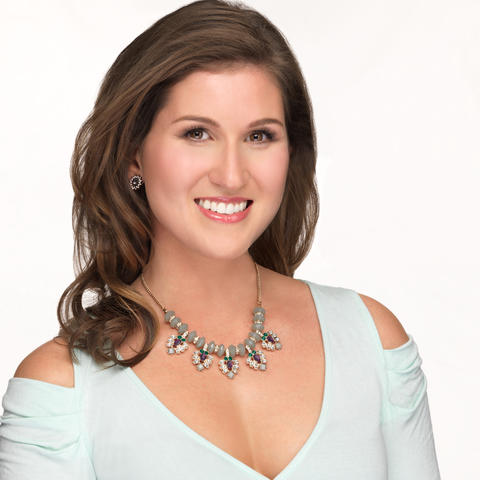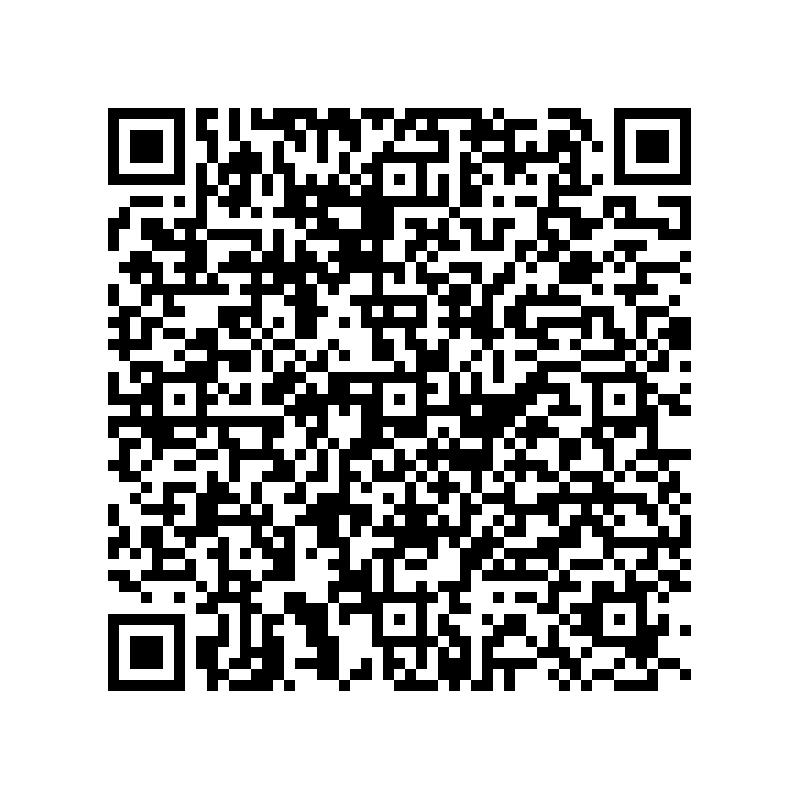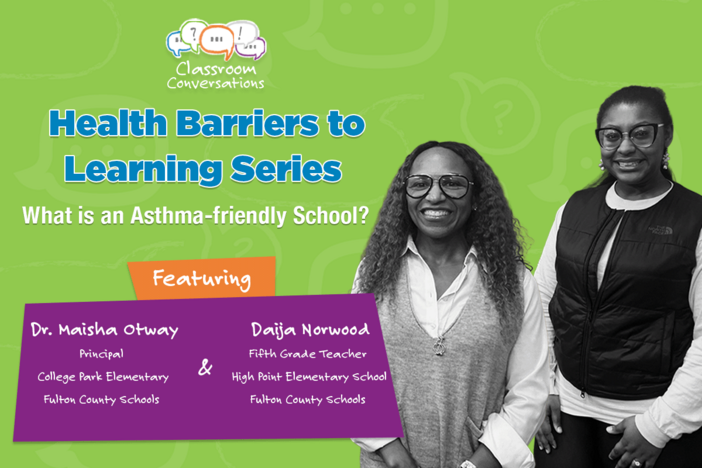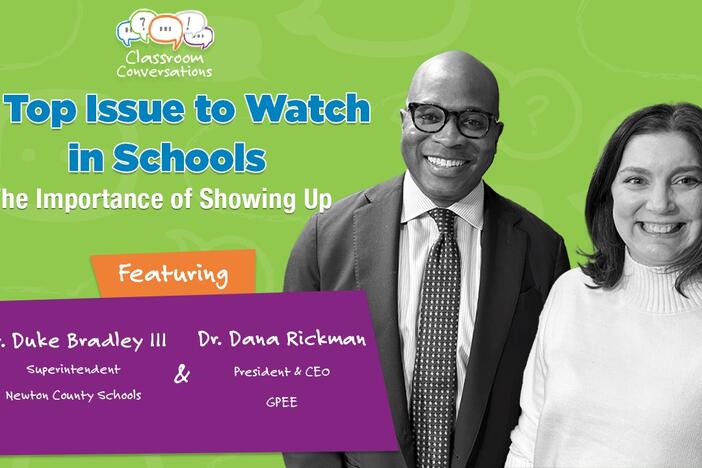
Section Branding
Header Content
Episode 202: “Good Morning, I’m So Glad You’re Here!”: The Importance Of Greeting Students At The Door
Primary Content
Kaleigh Moreno of Lowndes County Schools and Polly Anne Everritt of Muscogee County Schools discuss the importance of greeting students at the door.

Click here for discussion guide!
Kaleigh Moreno of Lowndes County Schools and Polly Anne Everritt of Muscogee County Schools discuss the importance of greeting students at the door.
TRANSCRIPT
Ashley Mengwasser: Greetings earthlings. I mean greetings educators, how are you? Greetings are particularly relevant to today's conversation. Thanks for tuning in to Classroom Conversations, the platform for Georgia's teachers. A place where you can share and learn. And we have the Georgia Department of Education to thank for sponsoring the series, which is produced in partnership with Georgia Public Broadcasting. Today in the realm of positive climate, we're meeting about greeting as we seek to understand why it's important to greet students at the door. Come on in. And in season two, episode two, in the year 2022, it's only natural to have two guests. Before I greet them, I'll just stare at their warm, patient faces as I introduce them to you. First up, Kaleigh Moreno is an elementary teacher, third grade reading and writing to be exact, in Valdosta, which is in Lowndes County. Kaleigh teaches at Clyattville Elementary School and here's how I'll tease Kaleigh's story (cat meowing). And our second teacher is a secondary teacher, Polly Anne Everritt, teaches at Jordan Vocational High School in Columbus, Georgia. That's in Muscogee County. Here's a clue about Polly Anne (goat bleating). Welcome Kaleigh and Polly Anne.
Kaleigh Moreno: Hi.
Polly Anne Everritt: Hi.
Ashley Mengwasser: Hi. Did I nail your sound effects?
Kaleigh Moreno: Yes.
Polly Anne Everritt: Totally.
Ashley Mengwasser: Totally? Good. We'll explain what that means in just a second. Kaleigh, tell us something interesting about yourself.
Kaleigh Moreno: Something interesting about me is that I have two cats that I adore very much and I rescued them both. So they've both inspired me to one day, have my own cat rescue. I recently got them a little thing to watch, but it's actually my classroom pet, which is a bearded dragon.
Ashley Mengwasser: What is a bearded dragon?
Kaleigh Moreno: Bearded dragon is right now a cute little reptile, but he will be ... he or she, we're not really sure yet, will be a large reptile that is going to help me teach responsibility and just have a friend around in the classroom.
Ashley Mengwasser: All right. Polly Anne, what about you? Any fantastical creatures in your home or classroom?
Polly Anne Everritt: Do you count goats?
Ashley Mengwasser: Yeah.
Polly Anne Everritt: Yes, fantastical. Yeah, I live out in the country, and we have all kinds of stuff. We have blueberry bushes, garden vegetables, pear trees, muscadine, scuppernongs, and goats. So, I like to put things up, can them, AKA can them, and make stuff fresh homemade from out of my garden, I've made everything possible from zucchini and pears and always have an abundance of those. So, my favorite thing to make I and put up or can is zucchini bread and pear butter.
Ashley Mengwasser: Oh my, you have our interest. What does zucchini bread taste like?
Polly Anne Everritt: Nothing like zucchini.
Ashley Mengwasser: Good.
Polly Anne Everritt: Yeah, it's very like cinnamon sugar sweet. It's like a sweet bread. It's very good.
Ashley Mengwasser: Zucchini is just the most amazing vegetable.
Kaleigh Moreno: It's such a versatile vegetable.
Ashley Mengwasser: It sure is. You guys are interesting people, which I love. I want to hear your why for choosing the teaching profession. Polly Anne, you first.
Polly Anne Everritt: Sure. I'm not one of those people who comes from a long line of educators. I'm the only person in my family that is a teacher. I did not even initially plan on going into education. It wasn't until my senior year of college, when a local high school needed a Spanish teacher in the middle of the year, and they needed them quickly. And so, they called on my alma mater Judson College to try to fill that vacancy as fast as possible. And since I've had a Spanish minor, I accepted the position. And so, then they just threw me into the classroom and I had no experience whatsoever, had no-
Ashley Mengwasser: Teaching Spanish?
Polly Anne Everritt: Teaching in general. Had no idea what I was doing, had not even taken an education class. So, it was learning experience, I enjoyed it. It was great. And I thought, "I can see myself doing this for long term." So, I went back and got a master's in education. That's how I got there, but why I'm still there is because of the positive relationships that I'm building with students. And there's a quote that speaks to me by Erin Gruwell. She says, "I realize if you can change a classroom, you can change a community. And if you change enough communities, you can change the world." So, I'm trying to make a difference in the Chattahoochee Valley area, in my classroom. And I understand that teachers have a tremendous influence on youth. And I hope that the healthy social skills that my students develop and shape in my classroom carries over into their personal lives. I want to have a positive effect on how they treat their coworkers on the job, strangers in the street, and their future families that they will grow.
Ashley Mengwasser: I'm certain that you do. Tell me about your school, just briefly.
Polly Anne Everritt: So, I am at Jordan Vocational College, Jordan Vocational High School, College and Career Academy. And we are blessed with a very diverse population of students. I love having students from a variety of backgrounds and skill levels in my classes.
Ashley Mengwasser: That's incredible. Okay, I want to hear your why for the teaching profession, Kaleigh?
Kaleigh Moreno: Yes. So, I always knew I wanted to be a teacher. When I was little, I used to set up my stuffed animals and print out worksheets off my grandma's like big box computer, like the big chunky ones.
Ashley Mengwasser: I remember it.
Kaleigh Moreno: And I would print off worksheets for them and teach them. And then it got solidified for me when I was in high school, I was working for VBS and there was a young girl who came in, who had disabilities and she was nonverbal. So, her grandma was there bringing her for just a part of the VBS experience. She told me like, "Hey, she probably won't talk to you, but she's nonverbal. She still understands what you're saying." So, I tried communicating with her in our own way. And her grandma was floored. She was like, "I've never seen anyone communicate with her like that." So, from that moment, I knew, "Okay, I want to be a teacher." Then I went to UNG in Dahlonega so that I could get my dual degree in early childhood and special education, so that throughout my career, I could have a choice where I wanted to go. But the reason why I stay is definitely for my students. I just love walking in every day and knowing that we're going to get to spend the day together, their personalities and just their outlooks on the world, especially the age that I teach is just so refreshing. So, that's why I stay, is for them.
Ashley Mengwasser: Third graders?
Kaleigh Moreno: Yes.
Ashley Mengwasser: How long have you been teaching?
Kaleigh Moreno: I've only been teaching for one year. This coming up year, starting in August will, will only be my second.
Ashley Mengwasser: Okay, so new to the game.
Kaleigh Moreno: Yes.
Ashley Mengwasser: And over here, Polly, we've got a veteran in you Polly Anne.
Kaleigh Moreno: Oh yes.
Ashley Mengwasser: How many years for you?
Polly Anne Everritt: 18.
Kaleigh Moreno: Wow.
Polly Anne Everritt: Here we go.
Ashley Mengwasser: You guys represent both ends of the spectrum. I love that so much. And tell me a little bit about your school, Kaleigh?
Kaleigh Moreno: So, I teach at Clyattville Elementary School and one of my favorite things about my school is how rooted in love we are. Every teacher that I work with has such a love for the children we work with, and it really pours over into the school culture and climate. I just love the support that we have for one another, not only for ourselves as teachers, but also for our students and families
Ashley Mengwasser: Support, we need it. All of us, especially at the student age, which is why you engage in a very important practice that we're going to talk about today. You're here because you're excellent greeters and that's a great skill for party hosts too, by the way. But we're about to find out why door greeter is one of the teacher's most foundational jobs. A class greeting is when the teacher stands at the door and greets students as they enter the classroom. I understand that research has shown that greeting students at the door helps them feel welcome, connected to their teachers, and it builds positive relationships as well. Let's dive into our interview, shall we? Tell us why you began greeting students at your door and why it's important? You go first Polly Anne.
Polly Anne Everritt: Well, early in my career, I just greeted students at the door because that's what the principal asked me to do.
Ashley Mengwasser: It's a good reason.
Polly Anne Everritt: It was more of a logistical reason and more adult supervision in the hallways equals less disruptive student situations. But later I actually began to realize that it helped set the tone for my class and my expectations. That immediate, initial positive interaction with students shows them that they're actually seen, and it even encourages participation in class.
Ashley Mengwasser: And you hand out stickers.
Polly Anne Everritt: I do.
Ashley Mengwasser: That would motivate me. What kind of stickers?
Polly Anne Everritt: Oh, it depends on the theme of my classroom usually. One year I had sloths, so I had sloth stickers.
Kaleigh Moreno: That's so cute.
Ashley Mengwasser: And high schoolers like this?
Polly Anne Everritt: Believe it or not, yes they do. I know there's a lot of people out there who go, "Oh my gosh."
Ashley Mengwasser: No, it's all life's simple pleasures. We need them at all ages. Kaleigh, tell us why you began greeting students at your door.
Kaleigh Moreno: I also began greeting students at my door because I was asked to.
Ashley Mengwasser: A commonality.
Kaleigh Moreno: Yes, but for me it also turned into more than just another adult in the hallway to watch students. It became a part of an ability to connect with each student and to make sure that when they're walking in the door every morning, they're seen and they feel like their teacher has prioritized that time and set it aside so that they can have a connection with their students every day when they walk in.
Ashley Mengwasser: I want to hear how you do it. Would you walk us through your approach?
Kaleigh Moreno: Yes. So, when students are released into the hallway, which at our school's about 7:30ish, I make my way to the door so that I'm there when my students make it to the door and I greet each student with a good morning and their name, and sometimes the students will have a little story to share, or they'll want an elbow bump, especially in the COVID times.
Ashley Mengwasser: Ah the elbow bump.
Kaleigh Moreno: Elbow bumping, fist bumping, or they might just say good morning back and then go have a seat. But one other thing that I've incorporated into our morning routine is a daily check-in, which is kind of like an extension to my greeting at the door. So, each student fills out a Google form when they have a seat and it asks questions like, "How are you feeling today on a scale of one to five. Pick which emoji is most like what you feel right now." Or I also have a little part at the bottom that says, "How can I be a better teacher for you today?" And there's a place for them to fill that out. So, it just is a check in with each kid at the door and at their desks before we get the day started.
Ashley Mengwasser: A little survey to see how they're doing which I'm sure helps you springboard into the lesson, that knowledge.
Kaleigh Moreno: Very much so. Just knowing where they start at the beginning of the day really helps to know where we're going to go.
Ashley Mengwasser: Right. Polly Anne, what's your greeting process?
Polly Anne Everritt: Well, so you mentioned my stickers. Often as I greet them at the door, I'm giving out an extrinsic motivator and stickers in this case. I know that all my high school teachers that are listening are going, "Oh, no way. My 16, 17, 18-year-old students are not going to care about a sloth sticker." But-
Ashley Mengwasser: Fair.
Polly Anne Everritt: That's right. Stickers are not elementary. You would be surprised at how motivated you can get a high schooler with a sticker. So, I do tie my stickers though, to a classroom motivational system, like restroom or homework passes. And as I greet them, I make a comment as to why they're receiving the stickers, such as, "Johnny, thank you for coming in on time." Or "Jill, I appreciate that you took out your head buds before even entering the classroom." So, this starts off the class in a positive way and leads to positive, respectful relationships between you and your students.
Ashley Mengwasser: What do you learn about them through this ritual? I bet you learned some surprising things, maybe sometimes more than you bargained for?
Polly Anne Everritt: Yes.
Ashley Mengwasser: You first Polly Anne.
Polly Anne Everritt: Well, this past year I had a student who wore her feelings on her sleeve. I could see her coming down the hallway and I knew what kind of mood she was in.
Ashley Mengwasser: Oh boy.
Polly Anne Everritt: I didn't even have to say good morning yet, but each morning, I do what always do greet her and start up a little brief conversation. And if she was not in the best of moods, by the time the tardy bell rang, she would usually be in a better place mentally and more open and ready to learn. But if she was already in a good mood, she would actually stand at the door with me out in the hallway and help me greet her classmates.
Ashley Mengwasser: A co-greeter.
Polly Anne Everritt: So, she was a hoot, but it was amazing to me that as a high school student, she was willing to step up and interact with her teenage peers that way.
Ashley Mengwasser: What do you learn about your kids?
Kaleigh Moreno: So much can come out of an eight-year-old at 8:00 in the morning. It's been really fun getting to hear their stories when they come in. A lot of times they're like, "Oh, can I tell you about my pet and what they did yesterday?" Or "I won my soccer game or my football game." So, they might share something like that, or they might share how they're feeling that day. Like if they come in and they're like, "My head hurts." So I make a mental note to make sure that I'm keeping track of that or making sure that if a kid comes in and maybe they're just a little off, they might be on my radar for the rest of the day, but also on the daily check-in, I have kids share stories like they would in person, to even the things as random as, "Miss Moreno, I have the hiccups today." And I'm like, "Oh, thank you for sharing."
Ashley Mengwasser: Do you try to cure them of the hiccups? Is the question.
Kaleigh Moreno: I told them the trick of taking sips of water. I don't know if it worked or not, I can't remember. It was in December that it happened. So, it feels like years ago.
Ashley Mengwasser: It does, I'm sure. Next time let's get some data on this and see if that actually works. I could see how this would be promoting positivity in the classroom. Tell me how. How has the strategy positively impacted your learning environment and student engagement? I mean, do you see things like reduction in office referrals? Do you see more student engagement? What are you seeing, Kaleigh?
Kaleigh Moreno: It's definitely been a positive impact on the learning environment. It helps build my relationships with students which really spills over into everything that happens in the classroom. One of my professors in college taught us that the basis of everything that we do as teachers always comes back to the relationships that you have with them. So, that has become like an integral part of who I am as a teacher. And so I know that if I take the time to stand there and greet them, that over time, that's going to form a relationship with that student, which spills into everything else in the room. So, with office referrals, I've been very blessed this year and I really haven't had that many, but in the situations where we have had office referrals, they've definitely decreased for this because when you form a relationship with a student, it creates the power of a conversation. So, when you see that behavior start, you know, "This student needs an intervention. We're going to talk in the hallway," and you already have that rapport with the student, so you're able to converse about it and come to the bottom of it before the behavior ever even becomes a problem. So, it's impacted our learning environment so much that even students have started doing it, where they missed out on a lot of integral or very important social interaction with the pandemic.
Ashley Mengwasser: Yeah, face-to-face time.
Kaleigh Moreno: Face-to-face. So, when we all came back together for a lot of our kids, this was the first time in a couple years that they had been in a classroom together. And I could notice how just greeting them at the door was starting to build their relationships with each other too. Not just with me. So, it's been a great, great thing in the classroom.
Ashley Mengwasser: So, for you, it's been relationship building.
Kaleigh Moreno: Yes.
Ashley Mengwasser: How has it positively impacted your classroom in high school Polly Anne?
Polly Anne Everritt: Well, greeting students starts the day off on the right foot for me, this definitely is a cornerstone to building a positive rapport with your students like you said. If you have to reprimand them or talk to them out in the hallway, they're more open to what you're saying.
Ashley Mengwasser: Really?
Polly Anne Everritt: Yes. They don't think that you're just picking on them or they feel like, "The only time you're talking to me is when you're getting onto me."
Ashley Mengwasser: Because you've already connected with them first in a positive way.
Polly Anne Everritt: Exactly, exactly. And so, you don't want every interaction you have with a student to be negative for the whole day, you know?
Ashley Mengwasser: Oh yeah.
Polly Anne Everritt: So, you want to start out positive. So since incorporating the greeting students at the door and positive behavior interventions in my classroom, I've definitely seen a decrease in office referrals. I always say that I would rather give up five minutes at the beginning of class, the first couple of weeks, setting up expectations and rituals and routines if it saves me from having to spend 20 or 30 minutes of valuable instruction time later on dealing with a discipline issue. It's like you said, it doesn't even happen. It doesn't become an issue.
Ashley Mengwasser: And it compounds on the back end, whereas this is a preventive measure.
Polly Anne Everritt: Right.
Ashley Mengwasser: Well, let's talk about the time thing, because you mentioned that a bit Polly Anne, taking time to greet students at the door. I could see how that could be time consuming for busy teachers like yourselves. Share how you manage your time to implement a proactive strategy like this every single day.
Polly Anne Everritt: So, I make sure that I have nearly everything ready to go the night before. In the morning, I want to be able to focus on what I have to do, like put the ‘do now” on the board or have my bell ringer ready to go. And then mentally run through my lesson plan for the day to make sure I have all of my websites, my programs, Google slides, do-dads, whatever you got going on, that they're easily accessible.
Ashley Mengwasser: Do-dads.
Polly Anne Everritt: Yes. And then it's just a matter of stopping what I'm doing and making my way to the door. And it's one of those things. If I don't happen to make it because I have to hit send on an urgent email, or across the hall and have to speak with a teacher, another teacher, the students will say, "Where were you Ms. Everritt?"
Ashley Mengwasser: Oh my goodness. They hold you accountable.
Polly Anne Everritt: Yes, they do.
Ashley Mengwasser: Yo, teach, where were you?
Polly Anne Everritt: And you want to be consistent with that. They come to expect that consistency and it keeps you on your toes. And so, you also want to set up your routines at the start of the year or semester. We work on semesters in high school where I'm at. You want it to become second nature. You don't want to feel like it's something that you have to remember to do. So, starting on day one, I greet them at the door and get that routine going. And then also, even after a break like Thanksgiving or spring break, when we come back, I'll go right back and reiterate my behavior expectations for several days, because that helps the students and the teachers back on track.
Ashley Mengwasser: Kaleigh, how do you carve out time for this?
Kaleigh Moreno: So, it's definitely no secret that we have so limited time as educators. So, I definitely try to, any time that I have something to do, I know that I've already set aside a time for that, so that this 30 minutes is uninterrupted every morning, that I can just be at my door, greeting my students. So, one thing that I do as well is I make sure everything is ready to go the day before when I go home, so that when I get to school the next morning, my lesson plans are out. All I have to focus on is putting up my lunch and getting my morning slide pulled up as well, but really just prioritizing it and knowing when I'm walking into the day that from 7:30 to eight o'clock, I'm going to be at my door, I'm going to be greeting my students because showing them that I prioritize that time with them will also in turn, make them prioritize their time with me.
Ashley Mengwasser: Absolutely, it's a tradeoff. Could you just think of a favorite example you had, there's got to be one about a particular student's greeting and how it impacted their learning for the day?
Kaleigh Moreno: Yes, actually, this one was a repetitive smile on my face every day. And they shared it through our daily check-in, which is kind of like the extension of our morning greeting. And every day, or at least I'd say twice or three times a week, I had one student who really loved to share a little blurb at the bottom, like an inspirational thing for me. And one thing that the student and I really connected over was how much we both love cats.
Ashley Mengwasser: Always the cats.
Kaleigh Moreno: Always the cats. But being able to have that little connection between the two of us meant that they loved to share something about it. So, every morning or most mornings, they would say, "Miss Moreno, I can't wait to spend the day learning with you, but your cats told me that they really want you to come home and watch birds on the TV with them in the evening."
Ashley Mengwasser: Oh, they're advocating for the cats now.
Kaleigh Moreno: They're advocating for the cats. So, just even though it's not academic, it still is a way that I can connect with my students, which spills over that much more into being ready for the day and being ready to learn, because they've had that moment of, "Oh, I got to feel connected with my teacher today. Now I'm ready to go."
Ashley Mengwasser: And something else that makes me think of when I was a student, is just the idea that learning retention can be connected to other things you remember. So, if you had this hilarious conversation in class about your cats and your future cat cafe dreams, they might remember that was a day that they learned about X.
Kaleigh Moreno: Yes. Those connections really make that stick in the brain a little bit more.
Ashley Mengwasser: Exactly. And we like things to stick because the older you get; it just flies right out. I don't even know where the knowledge goes. Polly Anne, do you have an example?
Polly Anne Everritt: I do. I actually have two. That student that I mentioned earlier, that wore her emotions on her sleeve. Well, the daily, positive encounter that I had with her at the door and really helped her get through some tough educational days because she was the type that if something got too hard, she would just shut down and give up. But because we had that positive relationship already built, I was able to pull her through some tough topics and concepts without her putting up a mental barrier. Then I had another student this year who was a tough cookie behaviorally. He was one of those that were just too cool for school types, you know? He had to keep up appearances for his classmates.
Ashley Mengwasser: I gotcha, I know the type. Yes.
Polly Anne Everritt: So, the daily personalized greetings helped to build up positive rapport with him, which not only helped his behavior in class when I had to correct him, that really made him actually open to the conversation. So, he knew that I was just ... wanted what was best for him. And he voluntarily corrected the behavior before it turned into an issue. He actually went and entire week where he volunteered to put his cell phone on my desk because he understood that it was beyond distracting for him.
Ashley Mengwasser: Disruptive, yes.
Polly Anne Everritt: It was, yeah, and it was starting to affect his academics negatively. And so, without the positive rapport that started at the door, that positive relationship, would've been much harder to build up.
Ashley Mengwasser: Right. Positive greetings, positive rapport, positive outcomes. You guys are really bringing it full circle. Well, shall we conclude with some enriching tips, maybe some suggestions you might be willing to share for other teachers who want to establish this routine? You want to go first Kaleigh?
Kaleigh Moreno: Sure. So, this one thing is something that really changed the trajectory of my entire first year of teaching. If I wouldn't have been there at the door, I feel like I would've missed out on so many relationship-building opportunities and positive interactions with my students. So, if you are wanting to do this, I say, go for it. I know that it can be hard at first to carve out the time, but you really never know when the reach of this five minutes of interacting with your students is going to end for that student. You don't know how far that impact is going to go. So for me, that makes it all that much more important because it may be 30 minutes for me, but it could impact that child's entire day or their whole week. So, making sure that we're prioritizing that time is something that's really important and hard to do at first. But I mean, the worth of it is just so much. And so, I would say that if you want to do it, plan out your time and make sure that you're at that door every morning and you'd be surprised just how enriching it can be. Not only for the learning environment, but also with you and that student.
Ashley Mengwasser: Be intentional is your message.
Kaleigh Moreno: Yes.
Ashley Mengwasser: What about you Polly Anne?
Polly Anne Everritt: Well, I say start with the basics and start on day one if you're interested in using this technique. A simple, good morning or good afternoon will do. I highly recommend including their names once you've learned them. For me, it actually helps me to match names to faces at the start of the year, so it's a deeper benefit. Consistency is key, turn it into part of your daily routine. So, you want the students to feel welcomed in your class and build a positive relationship. And this routine helps you build that respectful rapport before they even step foot into your classroom. And now, nearly all students are willing to verbally reply to my greetings at the door, but I understand that not all students are the same. So, actually I teach them how to appropriately respond.
Ashley Mengwasser: So you don't just get grunts.
Polly Anne Everritt: Right, so just like we teach our educational expectations, we should also teach our behavioral expectations. So, they know that they can acknowledge the greeting verbally, or they can do a head nod, a hand wave, or heck, I don't care, a peace sign, something, just whatever, however they're feeling for the day. But with that, it also gives me an immediate indicator of their emotional gauge for that day.
Ashley Mengwasser: I've really enjoyed being with you guys today. Thank you for being here.
Polly Anne Everritt: Thank you.
Kaleigh Moreno: Thank you for having us. It was a pleasure.
Ashley Mengwasser: You had a good time?
Kaleigh Moreno: Yes.
Ashley Mengwasser: I love that you taught us about greetings and the importance of them today. I also love a strong farewell. So, let's bring it home with this. Educators, as you are implementing these practices in your classroom, we hope they're successful. And as your students leave at the end of the day, take that moment of breath between classes to look around your class, to feel successful and know that you're a great teacher because you are. I'm your host, Ashley Mengwasser. Talk to you next time on Classroom Conversations, goodbye. Funding for Classroom Conversations is made possible through the School Climate Transformation Grant.
Kaleigh Moreno of Lowndes County Schools and Polly Anne Everritt of Muscogee County Schools discuss the importance of greeting students at the door.







